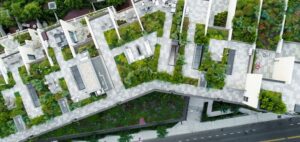While buzz around the passage of New York City’s Climate Mobilization Act in April 2019 has fizzled, the city’s public officials, property owners, architects, real estate moguls and financiers are revving up to put new policies into practice.
As of Nov. 15, 2019, Local Laws 92 and 94 are in effect to target a vast, often overlooked and underutilized resource in  New York: roofs.
New York: roofs.
The laws, known informally as the Sustainable Roof Laws, require most new buildings and buildings undergoing major roof reconstruction to include a sustainable roofing zone on 100% of the available roof space.
Sustainable roofing zones are defined as “areas of a roof assembly where a solar photovoltaic electricity generating system, a green roof system, or a combination thereof, is installed.” In other words, the roofs must have a solar panel array, green roof or both.
“When you fly into New York City, you see an amazing amount of unproductive roof space,” Jonce Walker, senior associate at Thornton Tomasetti, told Smart Cities Dive. Walker and others in the sustainable design community hope Local Laws 92 and 94 are going to change that.
Facing change
The Sustainable Roofs Laws have mobilized several sectors in New York City, from government to investment, each one grappling with how to manage new regulations designed to drive drastic changes in the city.
“The goal [of Local Laws 92 & 94] is to make sustainable roofs just one of the parts of how you put a good building together,” Mark Chambers, director of the Mayor’s Office of Sustainability, told Smart Cities Dive.
Currently, sustainable roofs are far from the norm in New York. According to a mapping project from The Nature Conservancy, there were only about 730 green roofs out of over 1 million rooftops in New York City in 2016.
Solar is much more prevalent, with a total of about 22,000 completed solar projects throughout the city as of 2019, according to the team at Sustainable CUNY. They indicate the number of new solar projects implemented each year in the city has increased dramatically since 2016, due in part to the establishment of Professional Certification (Pro-Cert), which shortened the review period of new solar projects to just 24 hours.
Not all property owners will be immediately faced with required adjustments. Buildings dedicated to affordable housing have an alternative compliance timeline of five years during which the New York City Department of Housing Preservation and Development (HPD) will conduct studies on the impact of the law on affordability.
But Jennifer Leone, sustainability officer at HPD, pointed out that the department has “already been leading the charge” when it comes to sustainable roof practices with programs like the Green Housing Preservation Program.
The case for green roofs
As the sustainable roof market has grown over the past decade, helped partly by the passage of new roof laws around the world, sustainable roofing systems have become the ideal solutions for eco-minded contractors and architects. But is one system better than another?
“To be honest, our very strong opinion…is that green roofs have more benefits,” said Walker. “If it’s either-or [green roofs or solar panels], we typically try to steer the design team toward green roofs.”
Water management
Walker and other green building advocates praise the wide range of social benefits that green roofs can offer. Beyond protecting roof membranes, they serve as a water management solution, soaking up stormwater that might otherwise contribute to the city’s already-overburdened stormwater management system.
During heavy storms, New York’s Combined Sewer Overflow (CSO) system is unable to handle excess stormwater, so untreated wastewater gets pumped into the city’s waterways. With additional green roofs to soak up that stormwater, New York may soon see cleaner waterways.
Stormwater and energy savings also contribute to a positive return on investment (ROI) in green roofs. While installation, replacement and maintenance of a green roof over a 50-year period can present a cost of $18 per square foot of roof, the stormwater and energy savings make up for the cost by providing a benefit of approximately $19 per square foot of roof over that same period, according to the General Services Administration (GSA).
Overall, GSA estimates that a 3-inch to 6-inch green roof covering 10,000 feet has a net present value of $2.70 per square foot per year.
Heat reduction
A city plagued annually by the urban heat island effect, New York might cool down with added green roofs. “Through the daily dew and evaporation cycle, plants…are able to cool cities during hot summer months,” according to Green Roofs for Healthy Cities.
Councilmember Rafael Espinal, a sponsor of the Sustainable Roofs bill, said green roofs have already been proven to cool cities. “These bills show that New York will not be idle in the face of an existential threat like climate change,” he said in a press release.
Biodiversity
Green roofs can restore biodiversity to urban areas by attracting pollinators like butterflies, bees, birds and bats that have been pushed out of the city as their natural habitats get bulldozed.
“This island was once a lush, green habitat that we have made impermeable,” said Walker.
The Javits Center, New York’s largest convention center, installed a 7-acre green roof in 2014 that now boasts 29 species of birds, five species of bats and three honeybee hives.
The pollinators are not the only ones benefiting from the Center’s green roof. The Javits Center itself harvests honey from the rooftop beehives, for sale at the convention center’s market.
For New York as a whole, focusing on increasing biodiversity can help improve the health of the entire city, as biodiversity is an indicator of clean air and waterways.
Well-being
Finally, green roofs might just make New Yorkers feel good. Marni Majorelle, founder and owner of Brooklyn-based green roof construction company Alive Structures, emphasizes the psychological benefits of having more green space in urban areas.
“I think it’s really important to have that connection with plants and with nature,” she said at a green roofs educational and networking event in June 2019. “I know there’s a lot of emphasis on reducing energy consumption…which is also extremely important, but we have to understand that we have to have nature in our cities.”
The case for solar
Although solar panels do not provide the same lushness to the cityscape that green roofs do, solar roofs have a number of attractive features.
Clean energy
From a sustainability standpoint, the primary benefit of solar panels is their ability to generate renewable energy. In a city with notoriously ambitious emissions goals — 100% clean electricity by 2040 and carbon neutrality by 2050 — increased solar supply can advance New York to reach those targets.
The solar market is also well-established in New York, leading to easier deployment of new solar projects. “There’s more infrastructure built up in the solar community [than in the green roof community],” said Majorelle. “It’s streamlined.”
Construction
Designers don’t always have a choice on how to construct a sustainable roof zone. Contractors conduct analyses prior to construction to determine which roof system will work best, based on the property’s available roof space and access to sunlight.
Roofs that get abundant sunlight and are unblocked by neighboring buildings, and especially those with sloped roofs, are prime for solar. Green roofs, on the other hand, cannot exist on a slope.
Finances
Solar incentives for property owners have been around in New York since at least 2005. New York’s solar market benefits from multiple tax incentives at city, state and federal levels. It is likely that some property owners will choose solar panels over green roofs, regardless of their benefits, to comply with laws at a lower cost.
While solar incentives are bountiful in New York, financial incentive plans for green roofs are limited to a property tax abatement of $5.23 per square foot of green roof, although alternate options like Property Assessed Clean Energy (PACE) financing also exist.
In addition to lower upfront costs, solar arrays are “revenue-generating machines,” in Majorelle’s words.
Affordable housing building owners and HPD have taken advantage of the earning possibilities of solar power. “Solar is the go-to option [for affordable housing],” Leone said. “There’s a visible payback.”
Paybacks are both direct and indirect, allowing building owners to save money on energy bills and even sell energy credits, earning them money that can then be allocated towards building maintenance costs.
Benefits beyond sustainability
While both green roofs and solar panels help reduce energy consumption and costs, combining the two systems may be the most cost-effective option. Solar panels work most efficiently when they are at a low temperature, while a green roof (which has a cooler microclimate) can reduce heat. However, there are currently very few combined solar-green roof projects in New York City.
Author: Cailley LaPara
Image by Alex Potemkin vis Getty Images


